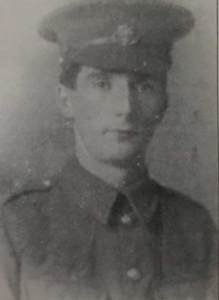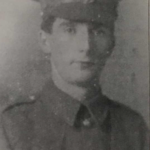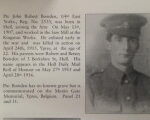
BORN HULL 1893. SON OF ROBERT BOWDEN (1864-1943) & BETSY JORDAN (1871-1945), OF 3 BERKSHIRE STREET, HULL (CWGC & WAR PENSION ADDRESS). HE HAD THREE BROTHERS AND THREE SISTERS. EMPLOYED AT RECKITTS SAWMILL & STARCH WORKS. HE JOINED RECKITT’S, ON 13/05/1907. HE ENLISTED IN HULL. POSTED TO FRANCE, ON 17/04/1915. SERVED WITH THE 1/4TH EAST YORKSHIRE REGIMENT. KILLED IN ACTION, AT YPRES, ON 24/04/1915, AGED 22.
HE IS COMMEMORATED ON THE YPRES, MENIN GATE MEMORIAL. HIS DEATH WAS REPORTED IN THE HULL DAILY MAIL, ON 27/05/1915 & 28/04/1916.
The 1/4th East Yorkshires were part of the Northumbrian Division and became part of Central Force in Home Defence, tasked with manning the Tyne Defences, so after some days digging trenches in South Holderness 4th East Yorkshires moved to Hummersknott Park, near Darlington to join the York & Durham Brigade. In mid-October it moved again, to Newcastle upon Tyne. While working on the Tyne Defences, the Northumbrian Division was also undergoing battle training. In April 1915 it was warned for overseas service with the British Expeditionary Force (BEF), and on 16 April its units began to entrain for the embarkation ports. The 1/4th East Yorkshires landed at Boulogne the following day. The Northumbrian Division completed its concentration in the Steenvoorde area on 23 April 1915, and went into action the very next day during the Second Battle of Ypres. The York and Durham Brigade went by motor bus to Poperinghe, where they debussed and marched to camp at Vlamertinghe. They were turned out at 01.00 on 24 April and marched to take over trenches astride the Yser Canal, where they came under shellfire at first light, 1/4th East Yorkshires losing their first casualties of the war. During the morning the battalion was shifted again, to a position near Potijze Château, where they dug in again. Meanwhile, the Canadian Division were coming under heavy pressure (the beginning of the Battle of St Julien). Finally, at 15.00 the tired battalion was ordered out to support a counter-attack by the Canadians and the 1/4th Green Howards of the York & Durham Bde (the Canadians were not informed of these two battalions’ involvement). The battalion moved up into a small wood and waited alongside the Canadian artillery under shellfire while the attack developed. Shortly after 17.00 the battalion was ordered to attack towards St Julien and advanced in ‘artillery formation’, with two platoons of D Company in front, led by Lt-Col Shaw. On reaching Bridge House the battalion swung north towards St Julien; it now came under heavy rifle and machine gun fire and was swept by Shrapnel shells and heavy howitzer shells. Eye-witnesses described the tired and hungry battalion behaving ‘as if they were doing an attack practice in peace’. At 950 yards (870 m) and again at 500 yards (460 m) the men opened rifle fire on the enemy, with little apparent effect. Coming upon a road the battalion could advance no further against the hostile fire, and took cover. Lieutenant-Colonel Shaw had been killed by a rifle bullet during the advance, and the CO of the Green Howards took over both battalions. The East Yorkshires were ordered to stay where they were until nightfall; they saw no sign of the Canadians who were supposed to be in St Julien, but their rifle fire combined with the Canadian artillery broke up a German attack from the village, and neither side held it at the end of the day. The 1/4th East Yorkshires was permitted to withdraw after dark; in its first action the battalion had lost three officers and 12 other ranks killed, 66 wounded and 17 missing, of whom 10 were known to be wounded.

